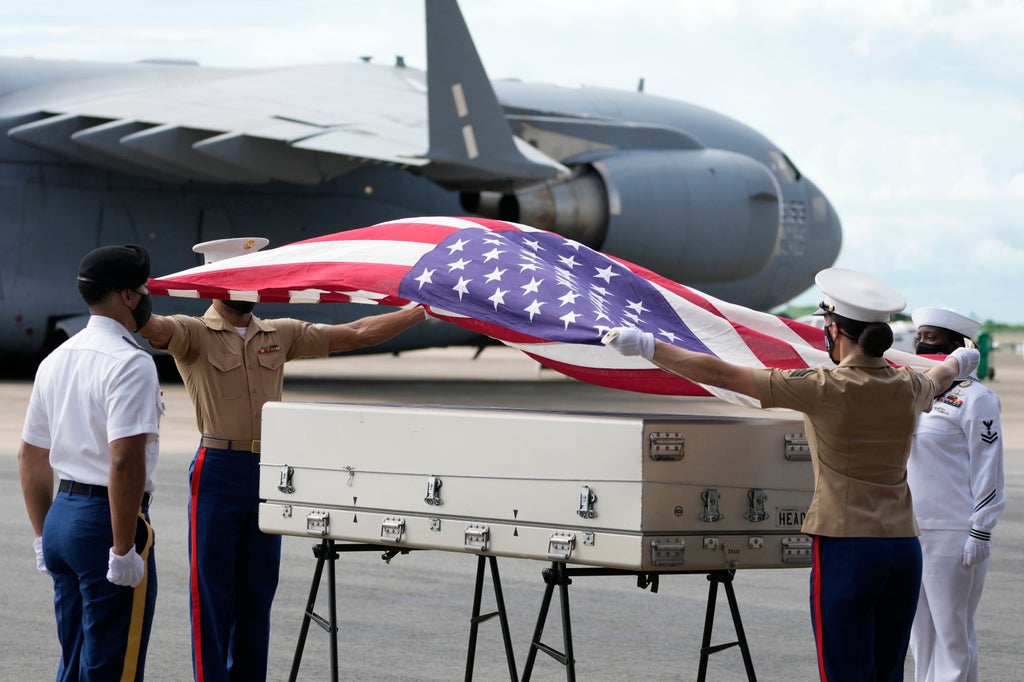
The remains of an American airman who went missing in action in World War II may finally be on their way home, thanks to a chance discovery of records in flood-threatened archives in Thailand.
U.S. and local authorities held a solemn ceremony Wednesday at an air base in eastern Thailand to honor and repatriate remains recently recovered from a rice field in the north of the country.
At the U-Tapao naval air base on Thailand’s eastern seaboard, military personnel along with Thai and American officials paid their respects. A casket containing the discovered remains was draped in the U.S. flag before being taken to the United States aboard a C-17 transport plane.
Tests at a special laboratory in Hawaii will determine if the remains are human and possibly identify the person. But circumstantial evidence has raised expectation the casket holds a long-lost service member from the U.S. Army Air Forces.
“You know, it’s keeping the promise that we never leave a person behind. Anybody’s who’s served in combat in any way, who’s fought alongside somebody, regardless of country or nation, there’s a bond that’s built. We owe it to the families to find those answers, to bring those people home,” said Marine Col. Matt Brannen, who heads up the Indo-Pacific directorate of the Defense POW/MIA Accounting Agency, or DPAA, the U.S. body tasked with finding the war missing.
Thailand was officially allied to Japan in World War II and occupied by its military, making it a target for British and U.S. bombers. Inevitably, aircrew from the Allied side were lost in action.
Today, just a few American flyers who disappeared over Thailand are still unaccounted for. As time passes, the chances of finding them all but vanish — unless something extraordinary happens.
In 2011, massive floods that hit the country inundated Thailand’s Air Force Museum in Bangkok. There was concern its archives might be damaged by mold. Retired Thai Air Chief Marshal Sakpinit Promthep, who indulged his passion for Second World War history by working part-time in the archival section, spent months afterward going through its files one by one to check their condition.
That’s how he found himself looking at a faded document from a musty, dusty folder. It was a handwritten police officer’s report dated November 1944. It detailed the crash of a U.S. P-38 plane, reported to have been struck by lightning during a storm.
It sparked a “Eureka!” reaction for the history buff who'd heard rumors of a World War II plane crash in Lampang province but had never found any record of it.
“This is a great moment in life, that we find such a thing just in front of you pop up!” he told The Associated Press. “You imagine, you look for something, you like to see it and there’s no hope, almost no hope to find it. Just open page, page and then – whoop! – in front of your eyes. Wow! This is what I am looking for,” he enthused, smiling broadly.
He said that as he held the report in his hands that day, he wondered whether the pilot’s ghost was at his shoulder.
“He may know that I am looking for him, searching for him for a long time,” said Sakpinit, suggesting that just maybe, the pilot’s spirit put those pages in front of him, in that file. "Otherwise, if there was no flood, the document's going to be hidden for maybe another year or many, .... maybe a long time.”
The U.S. War Department's files on missing World War II air crew members includes a pilot who took off from southern China for a reconnaissance mission over Myanmar and northern Thailand and did not return, the location and cause of crash logged as “not known.”
But his P-38 disappeared the same day the same type of plane crashed in Mae Kua village. The U.S. records identify the plane as an F-5E, a P-38 stripped down and modified for reconnaissance duty.
The AP is withholding the pilot's name, pending positive identification of the remains and notification of relatives.
Crucially, the police officer’s report in the Thai archive gave a precise location. Still, it took a decade to go from the musty folder Sakpinit held to the actual excavation. An interview with a 100-year-old woman who heard the crash was among the evidence that convinced DPAA investigators the site had merit.
In February, a joint U.S.-Thai search team dug in a rice field in Lampang’s Mae Kua village.
By April, the team had found a multitude of small metal fragments consistent with a crash as well as “osseous material” — teeth and bones.
“We’re approaching the 80th anniversary of World War II, so being able to get that information so our historians and analysts and researchers can develop those cases, it definitely is a race against time,” the DPAA's Brannen said.
According to the DPAA, of the 72,335 U.S. service personnel still missing from World War II, almost 47,000 disappeared in Asian battle zones.







